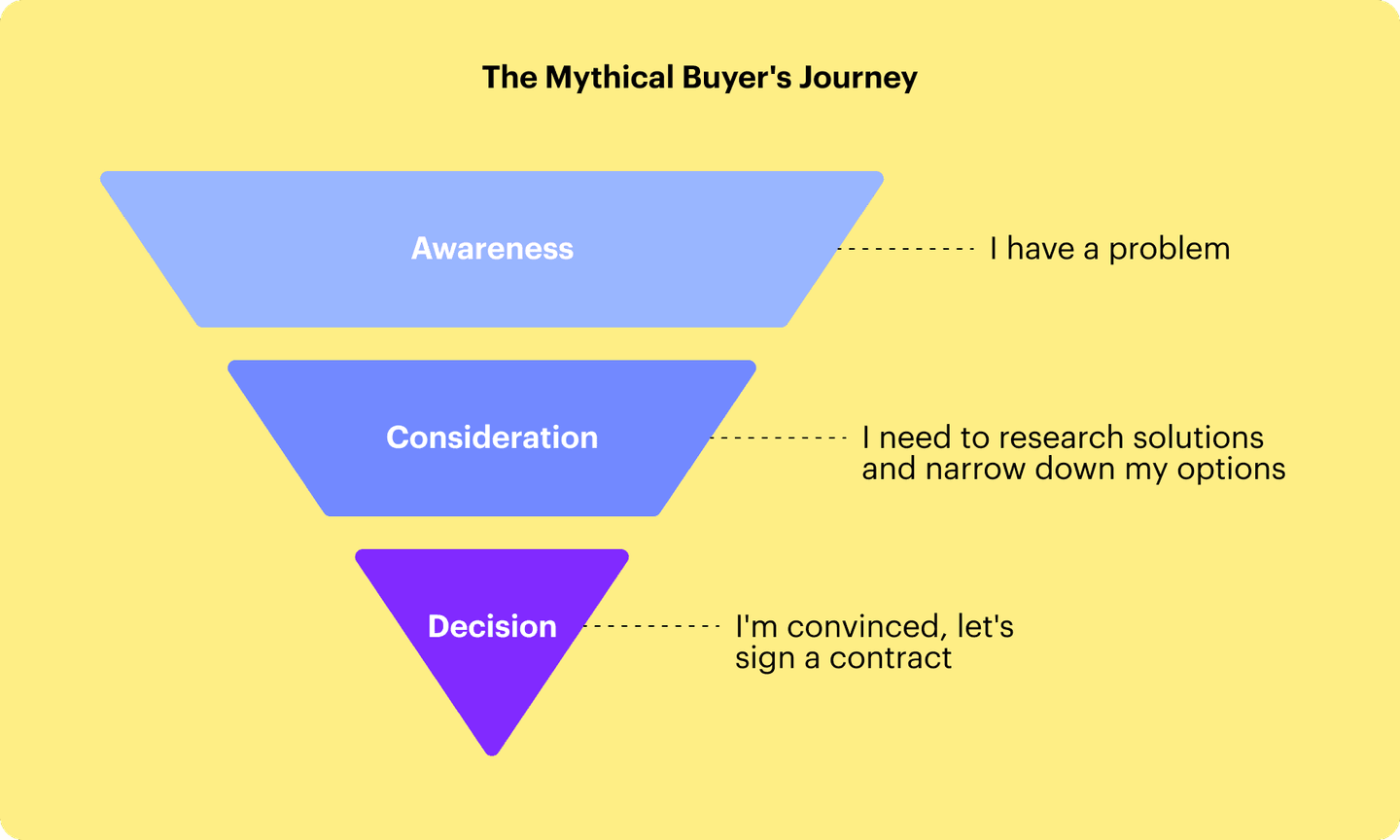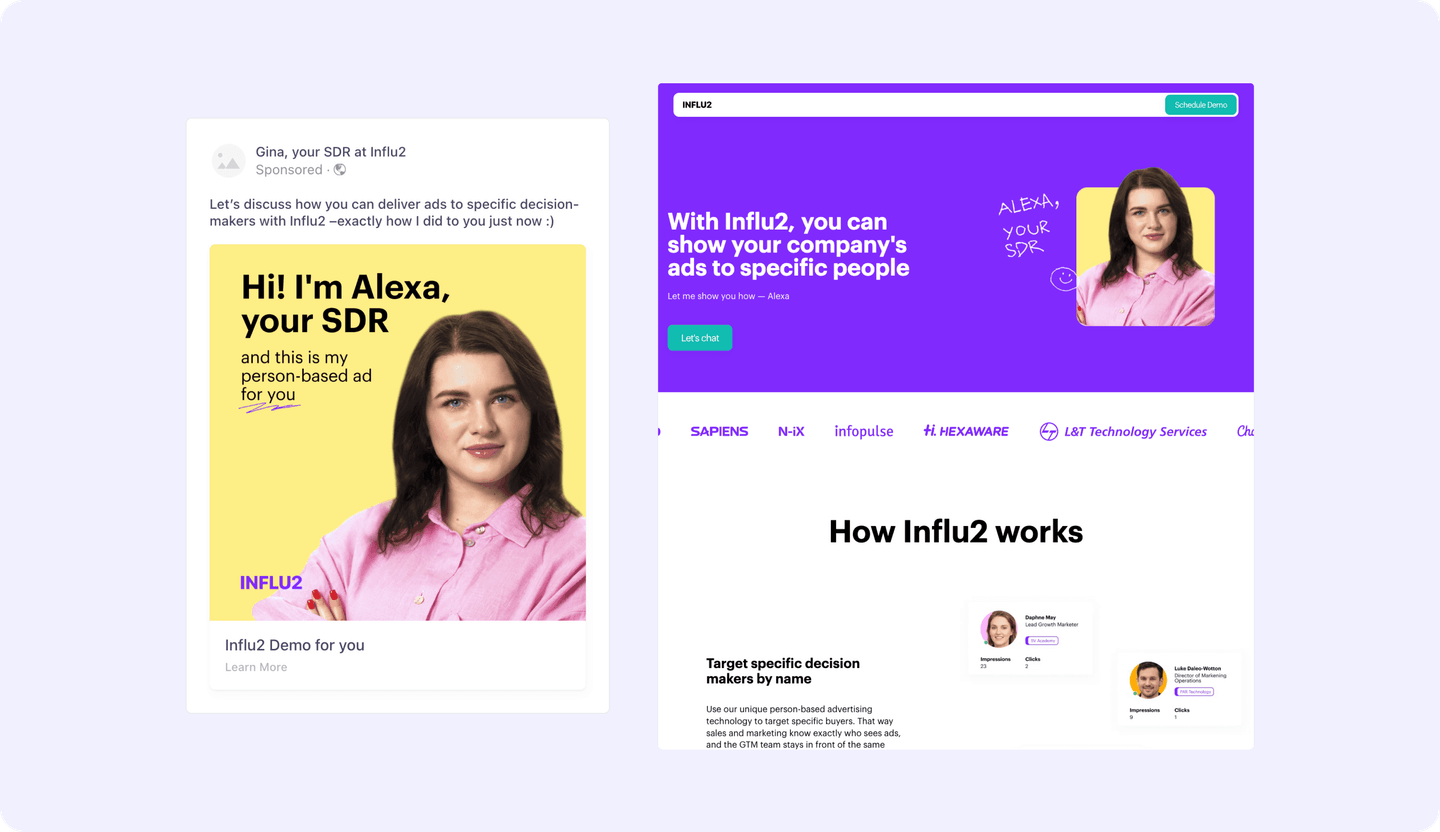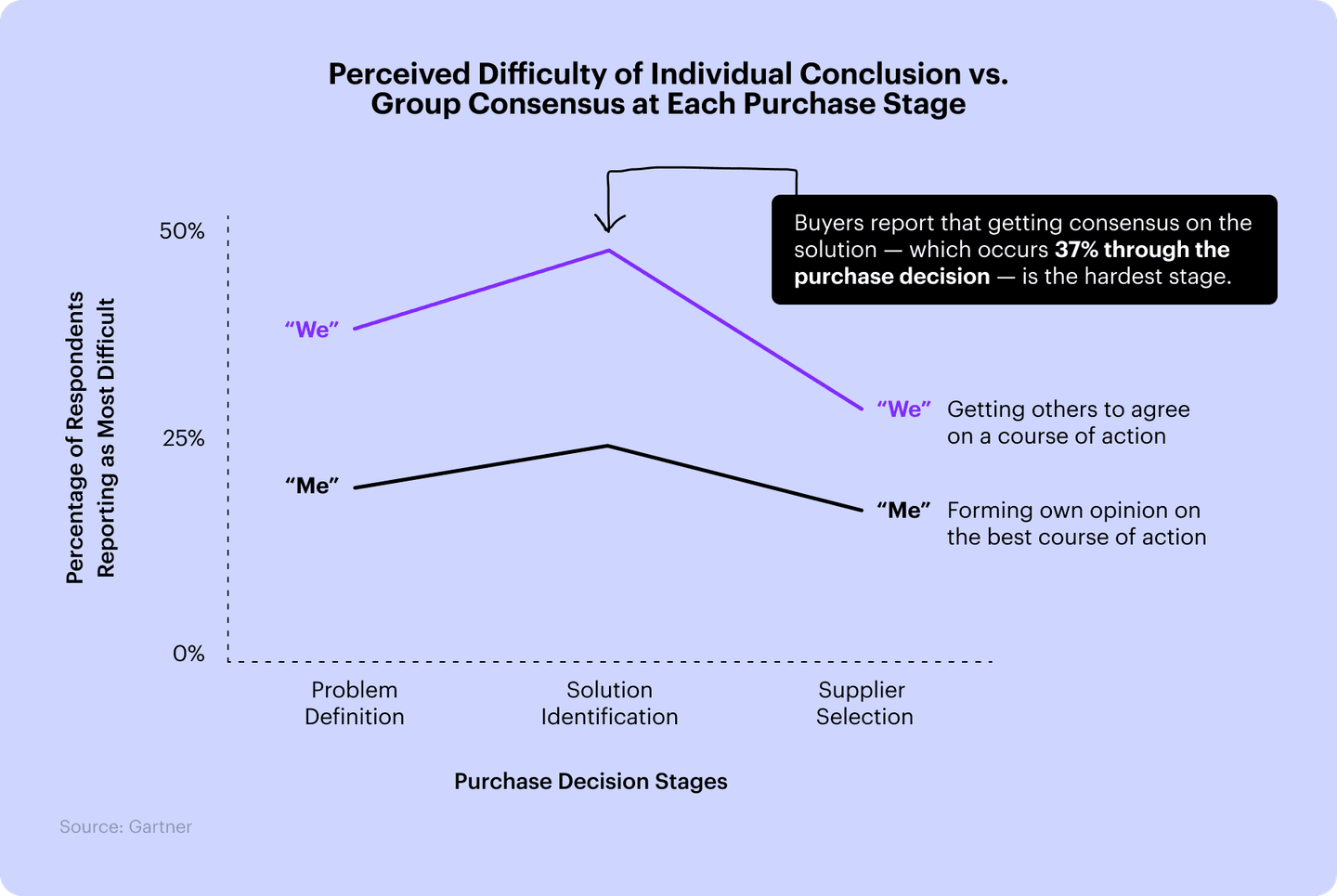The B2B Buyer’s Journey Isn’t Linear (Here’s How to Adapt)
Marketing folklore tells us that our buyers move neatly through a linear, four-stage buying journey. But, like the mythical Big Foot – has anyone really seen this?
Doubtful – especially in the enterprise B2B space.
The truth is: “traditional” linear buyer journeys never reflected the B2B buying experience.
That’s a problem for revenue teams building go-to-market (GTM) strategies based on this mythical promise of a linear journey.
A misaligned GTM strategy wastes money, resources, and time—without delivering results.
The dominoes fall from there. The data guiding your strategy is unreliable, so you can’t confidently improve results.
Not to mention – you see a whole lot of unhelpful finger-pointing between sales and marketing teams.
Let’s put down the pointing fingers and focus on how adapting your GTM strategy to the real B2B journey can help buyers make decisions.
The truth – buyer journeys were never linear; we just wanted them to be.
The traditional buyer journey is neat and linear, visualized as a vertical funnel or horizontal flowchart.

The framework follows three (sometimes four) rigid stages:
Awareness (or problem identification)
Sam, a Chief Marketing Officer, realizes his team spends three days pulling reports out of six different MarTech tools to complete monthly reporting.
There’s got to be a way to use fewer tools, speed up reporting, and gain a more complete picture of performance, right?
Consideration
Sam starts researching marketing platforms to see what’s out there and compare features against his existing tech stack. He asks his peers on LinkedIn and checks out reviews on G2.
He’s narrowed down his options.
Decision
Sam signs up for a product demo with a sales rep. He’s sold by their pitch and makes the budget request to his boss.
Budget in-hand, Sam signs on the dotted line.
Post-Purchase
This step often gets excluded from most buying journey frameworks.
Sam and his team fly through implementation and love the product. Over time, they expand across other areas of the SaaS suite.
This traditional framework assumes orderly progression through each stage. Our friend Sam’s buying journey was predictable, straightforward, and quick.
While it correctly acknowledges that marketing shouldn’t be one-size-fits-all, it oversimplifies outreach by fitting customers into tidy little boxes.
Here’s the thing though: the B2B buying journey is rife with indecision, too many stakeholders, budget chokeholds, and intense competition. It’s anything, but simple and linear.
The reality of B2B buying habits – embrace the chaos
Here’s when we: “find out what happens when people stop being polite and start getting real.”
Effective GTM strategies reflect buyers’ reality, meet them at key moments, and influence their decisions.
Let’s take a look at what Sam’s buying journey really looked like:
- Reporting’s taking forever; too many tools are creating data silos. Sam has a problem. But, he’s busy and has to finish up reporting and prep for the board.
- Later, he sees a peer on LinkedIn talking about solving this same problem. They chat, and Sam checks out the website his friend recommends.
- Sam’s excited – the tool looks like it could really help his team. He signs up for a free trial.
- Sam attends a conference for a few days; reporting issues forgotten.
- After the conference, Sam’s playing catch up. His free trial expires, but he’s focused elsewhere.
- Weeks later, he sees an ad for that product. He revisits the website and sends it over to his boss on Teams. His boss says, “looks cool, but not a lot of budget room ‘til next quarter.”
– and so it goes.
Sam’s journey is unwieldy; his urgency ebbs and flows with dozens of variables competing for his time.
He’ll inch forward, but then double-back to answer questions, gather proof points, or understand competitive options. He’ll have to make the case to his boss and sell internal team members on this new purchase.
Far from a straight line, Sam’s journey looks a lot more like this:

Chaotic and unique to individual circumstances, the average B2B customer journey stretches over 6 months from the first anonymous touch to closed won.
In more complex journeys (e.g., enterprise deals) the process can take over 12 months. There’s red tape, long approval processes, and a whole lot out of your control.
If your GTM strategy isn’t built for this non-linear journey, you can’t influence your buyers in meaningful ways.
Let’s explore how to adapt sales and marketing processes, tools, and strategies to reflect how people at B2B companies really make buying decisions.
Support self-serve buyer research, even in ‘dark’ spaces
Research shows that buyers spend the majority of their buying journey self-educating, long before they reach out to a salesperson. Gartner found:
- When B2B buyers are considering a purchase, they spend only 17% of that time meeting with potential suppliers and even less (5-6%) when comparing multiple suppliers.
- Plus, 75% of B2B buyers prefer rep-free experiences altogether.
On top of this, more of the buying journey happens in the Dark Funnel – places you can’t easily track, like Slack Groups, LinkedIn messages, internal meetings, or cookie-less browsing sessions.
Ultimately, sales reps have smaller windows to impact buying decisions.
By the time a meeting’s set, the person’s mind is close to made up through self-serve research and internal conversations.
Here’s how to support self-serve research:
1. Create resources and buyer enablement content for a variety of buyer personas, pain points, and stages
Your content should help different job roles answer questions, compare solutions, understand features, address implementation concerns, and visualize the valuable outcomes they’ll achieve.
For example, Chief Marketing Officer Sam wants to understand:
- How are other CMO’s dealing with this issue? A webinar or panel interview lets Sam hear from peers how common this challenge is, and how other CMOs solve it.
- Will implementing a solution totally disrupt our team? An Implementation Guide or one-sheeter answers common questions, explains implementation milestones, and offers a sample roadmap.
But, Sam’s Senior Marketing Manager Beth? She’s wondering:
- Which solution makes it easier to run more advanced campaigns? A Product Comparison webpage helps Beth evaluate popular products’ features, use cases, and customer ratings against one another.
- How big is the learning curve? A Virtual demo helps Beth check out the UI and visualize how her team will use the solution.
Blog posts, case studies, videos, interviews, ROI calculators, trend reports, and more help Sam and his team find information that matters most to their roles and buying considerations.
It seems like a lot, but speed up content creation by repurposing a larger initiative – like a report, interview, or webinar – into smaller pieces (like a blog post or social carousel).
Then, further tailor content pieces to each persona to deliver helpful resources across the buying committee.
2. Launch engagement-based ad journeys
Engagement-based ad journeys serve highly personalized content to a targeted contact, and then shift future messaging based on how that person interacts.
Here’s what an engagement-based ad journey might look like for Sam:
- Initially, Sam sees ads with pain point-specific messaging, like how simplifying your tech stack improves reporting.
- Since Sam clicks the ad, he’ll next see more advanced content, like a case study: Fortune 500 CMO Cuts Reporting Time by 73%.
- Soon, Sam signs up for the free trial and starts seeing ads featuring the sales rep assigned to his account. At Influ2, we call these “high-impact ads that make a direct connection between Sam and the SDR.

Engagement-based ad sequences help you capitalize on moments of heightened activity by serving advanced content or, change messaging when activity ebbs – reflecting a realistic buyer journey, with all its ups and downs.
If you want to learn more about how our team uses engagement signals across multi-month buyer journeys, check out our ABM Framework.
3. Sales needs to recognize re-engagement patterns (not just look at last touchpoints)
Like a breadcrumb trail, review combinations of data points to figure out buyers’ challenges, interests, and urgency.
Focus on who’s engaging, what they’re engaging with, and when that engagement is happening to effectively time outreach and personalize conversations.
Examples of high-intent re-engagement signals are:
- Previously inactive lead now binge-reads multiple content pages.
- Key stakeholders or multiple individuals from the same company visit BOFU webpages within a close timeframe (e.g., the CFO and two marketing managers read your pricing page in the same week).
- Buyer signs up for a live demo, watches a video, or views an interactive demo.
- Inactive lead reads older marketing emails or replies to an old email thread, after a sales conversation went cold.
- Past prospect lost due to budget constraints now clicks your re-engagement ad.

These re-engagement signals suggest your buyer’s busy doing self-serve research and internal conversations are happening at the company.
We love this advice from Amanda Hunter, Marketing & ABM Strategist at Amanda In Motion, on prioritizing engagement signals.
Sell across the account buying committee, while personalizing the experience
In enterprise B2B sales, you’re never selling to just one person. You need to win over the entire buying committee (e.g., the boss, end-users, IT, and finance).
Buying committees are only getting larger, at a time when everyone is scrutinizing budgets. The result is longer sales cycles, rife with indecision.
The average B2B buying group now includes 11 active members, each with influence over the budget and their own perspective on needs and urgency. Gaining consensus is the most challenging stage.

You’re going to need to understand the makeup of the buying committee and each roles’ biggest challenges, turn offs, and goals.
Arm yourself with success stories, proof points, rebuttals, and examples to answer each person’s questions and personalize your pitch.
Here’s how to sell across buying committees:
1. Embrace multi-threaded outreach by serving content to multiple stakeholders (across teams) within an account
Deals are 37% more likely to close when more than one contact is engaged, and cross-department threading has the potential to increase win rates by 56%.
Makes sense, right: if sales, marketing, and IT are all making the case for a new solution, it’s going to be an easier sell to leadership.
Use these tactics to take a multi-threaded outreach approach:
- Don’t put all your eggs in one basket – nurture relationships and find Champions at different seniority levels and departments.
- Send targeted emails with content specific to role and level, to start creating brand awareness, generating excitement, and resolving unanswered questions.
- Deploy contact-level advertising across the buying committee, advancing content strategy based on engagement (e.g., engagement-ad sequences).
- Ask your internal Champions for introductions, or ask “who else should join the conversation” early on to start opening doors across departments.
- Look to your network and team members to see who has connections (particularly to leadership) within the account to make introductions.
A huge benefit to multi-threading is your deal doesn’t die if your Champion leaves or gets busy. You have multiple relationships to lean on, build internal buy-in, and continue to advance momentum across the account.
2. Equip champions with internal selling materials to help them persuade their team
Sales decisions happen when you're not in the room.
If your Champion isn’t armed with the right information, they may struggle to advocate for your solution.
First, map out the buying committee – who makes the decisions, what roadblocks they face, and what they care about most.
You can ask your Champion for this information, but most likely, you’ll be inferring it from different conversations over time and piecing it together.
Then, equip your Champion with resources to answer questions and address hesitations:
- Pre-recorded demos, so they don’t have to explain everything themselves.
- Competitor comparison sheets to proactively address internal objections.
- Customized presentation decks to take into internal meetings.
- Testimonials and case studies to demonstrate proof points and real user experiences.
- Business impact content to answer executive-level questions around costs, ROI, competitive advantage, and industry benchmarks.
- Your subject matter experts (SME) to support internal conversations, answer questions, and ease concerns.
Think about the materials you lean on most throughout a sales journey and package them up for your Champion, so they don’t need to work harder to guide the sales conversation.
That last part’s important – don’t just throw a bunch of materials over the fence. Make sure your Champion knows how to use each piece and when, encouraging them to pull you into any conversations to offer support.
Adapt tools and processes to gain a clear picture across the entire account
Because most tools and processes reflect the linear buying journey, we’re simply not getting reliable data to truly understand our buyer, as they criss-cross through decision-making stages.
This means we’re triggering content and campaigns based on unreliable data, making it nearly impossible to target opportune moments in the buyers’ journey or improve future strategies based on past learnings.
MarTech tools and strategies have come a long way. Gain better data and capture actions across the messy B2B buyer journey, by looking for tools that:
1. Track the entire buying group (not just one person)
Capture a complete picture of stakeholders within the account, analyzing marketing and sales activity and its influence.
This holistic view will help:
- Revenue teams to tailor GTM motions for incremental improvement, better allocate budget, and accurately attribute marketing and sales influence.
- Marketing to better warm up contacts with hyper-relevant content and improve campaign performance.
- Sales to prioritize lead follow up and guide more meaningful conversations.
Influ2’s contact-level targeting gives this holistic view of ad performance across the buying committee, through audience cohorts.
For example, you can see in a friendly dashboard:
- The different contacts you’re targeting in the buying committee.
- The ads they see (now and historically).
- The actions they take with each ad.
- KPIs, like reach, influence, impressions, clicks, and CTR – at both the cohort or individual contact level.
This replaces the idea of buying committees as faceless lists of roles and pain points to reflect living and breathing people, and show how ads influence their real buying journey.
2. Use engagement data to detect real buying intent vs. surface-level interest
First, consolidate your data in one place (like your CRM, marketing tool, digital advertising platform, business intelligence tool, or another system), so you can see the big picture and properly act on engagement signals, like:
- CRM data: Account status, pipeline stage, contact role assigned, call booked/canceled, company revenue, recent funding, job title, industry, location.
- Marketing data: Webinar/event attendance, content downloads, demo sign ups, webform fills, frequency/recency of interactions.
- Engagement data: Ad impressions/clicks, ad creative consumed, email opens/clicks, webpage visits.
Knowing how to confidently approach buyers across their journey is the biggest flex and frequently shortens sales cycles.
At Influ2, we’ll move buyers from engagement stages (advanced content to capitalize on engagement) back to nurture stages (showing trust content to stay on their radar), when activity signals slow.
This keeps us visible without overwhelming, so we're top of mind when the timing is right.
The B2B journey isn’t predictable, but your GTM strategy can be
Buyers move at their own pace, influenced by shifting priorities, internal debates, and countless digital touchpoints. They’re busy, conflicted, and risk-averse.
The B2B buyer’s journey isn’t simple and tidy. The linear model is closer to a figment of imagination, than reality. (I give you: Big Foot.)
You don’t need it. By adapting your GTM strategy, you can meet buyers and accounts exactly where they are to guide decisions – not force them.
You can help buyers feel good about these critical business purchases, while learning what moves them to respond, trust, agree, and buy.
With Influ2, you can do this for every contact, account, and ad, or zoom out to see the big picture – it’s your journey.
Dominique Jackson is a Content Marketer Manager at Influ2. Over the past 10 years, he has worked with startups and enterprise B2B SaaS companies to boost pipeline and revenue through strategic content initiatives.


